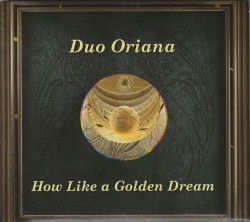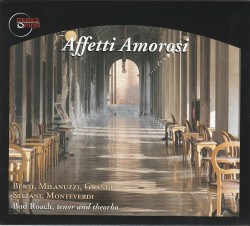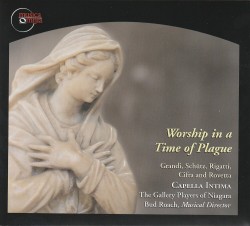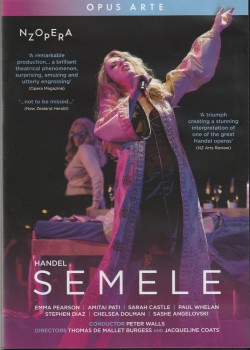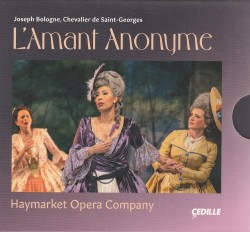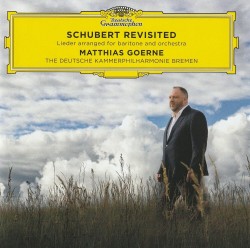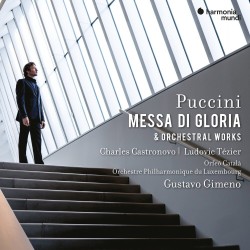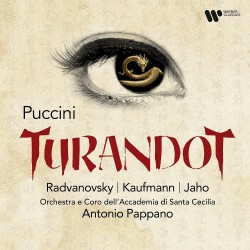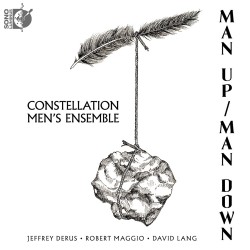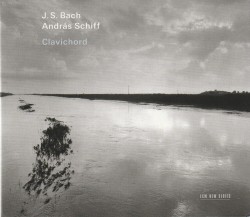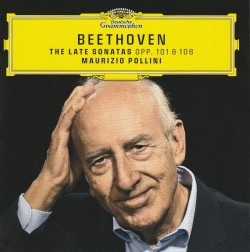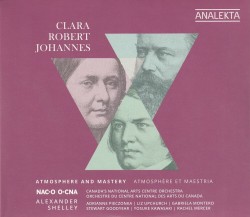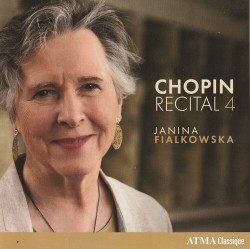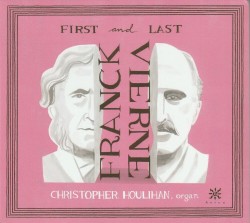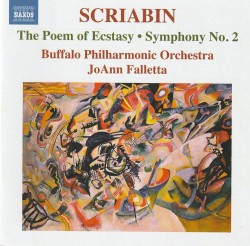Strings Attached - June 2023
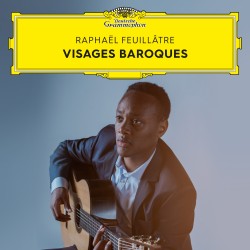 The French guitarist Raphaël Feuillâtre cites his desire to share his love for Baroque music as the reason he chose Visages Baroques, a recital of transcriptions of works mostly written for solo harpsichord, as his debut album on the Deutsche Grammophon label (00028948640737 deutschegrammophon.com/en/catalogue/products/visages-baroques-raphael-feuillatre-12899).
The French guitarist Raphaël Feuillâtre cites his desire to share his love for Baroque music as the reason he chose Visages Baroques, a recital of transcriptions of works mostly written for solo harpsichord, as his debut album on the Deutsche Grammophon label (00028948640737 deutschegrammophon.com/en/catalogue/products/visages-baroques-raphael-feuillatre-12899).
The two major works are Bach’s Concerto No.1 in D Major BWV972, itself a transcription of a Vivaldi violin concerto, and the Partita No.1 in D Major BWV825. Bach’s Prelude in C Major and Gavotte en Rondeau bookend a recital which also includes works by the French composers Antoine Forqueray, Jean-Philippe Rameau, Joseph-Nicolas-Pancrace Royer and Jacques Duphly, the latter’s brilliant Médée a real highlight.
Feuillâtre plays with complete technical command, crystal-clear definition and effortlessly clean movement, the tone, colour and phrasing being all that you would expect from the 2018 winner of the Guitar Foundation of America International Concert Artist Competition.
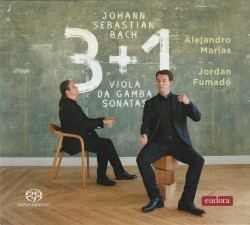 Alejandro Marías (Viola da Gamba) and Jordan Fumadó (harpsichord) are in superb form on 3 + 1 Bach Viola da Gamba Sonatas on the Eudora label (EUD-SACD-2302 eudorarecords.com).
Alejandro Marías (Viola da Gamba) and Jordan Fumadó (harpsichord) are in superb form on 3 + 1 Bach Viola da Gamba Sonatas on the Eudora label (EUD-SACD-2302 eudorarecords.com).
The three original works here – the Sonata in G Major BWV1027, the Sonata in D Major BWV1028 and the Sonata in G Minor BWV1029 – were not conceived as a set, and no contemporary manuscript contains all three. Composition dates are uncertain, and the sonatas may be reworkings of previous scores; BWV1027 definitely is, and is also the only one of the three extant in Bach’s manuscript, the other two existing in 1753 copies by Christian Friedrich Penzel.
Completing the recital is the Sonata in G Minor BWV1030b, a post-1770 transcription of Bach’s Sonata for Flute and Harpsichord BWV1030 by Johann Friedrich Hering, its demanding solo part bringing an outstanding recital to a close.
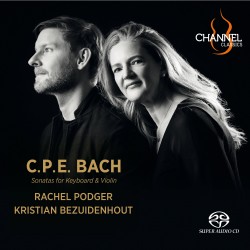 Violinist Rachel Podger is joined by Kristian Bezuidenhout on harpsichord and fortepiano in an outstanding recital of C.P.E. Bach Sonatas for Keyboard & Violin (Channel Classics CCSSA41523 SACD outhere-music.com/en/albums/cpe-bach-sonatas-keyboard-violin).
Violinist Rachel Podger is joined by Kristian Bezuidenhout on harpsichord and fortepiano in an outstanding recital of C.P.E. Bach Sonatas for Keyboard & Violin (Channel Classics CCSSA41523 SACD outhere-music.com/en/albums/cpe-bach-sonatas-keyboard-violin).
The duo sonata’s form and style were open and changeable during the composer’s lifetime, and his own imaginative and inventive works for violin and keyboard cover a 50-year period from the 1730s to the 1780s. The two sonatas with harpsichord are the Sonata in G Minor H.542.5, the earliest work here and possibly a collaboration with his father Johann Sebastian, and the Sonata in D Major WQ.71, a 1746 reworking of a 1731 original.
The works with fortepiano are the Sonatas in B Minor WQ.76 and in C Minor WQ.78, two of a set of four from 1763, and the Arioso con variazioni per il cembalo e violino in A Major WQ.79, a 1780 reworking of an earlier solo keyboard work.
There’s brilliant playing from both performers on a superb disc.
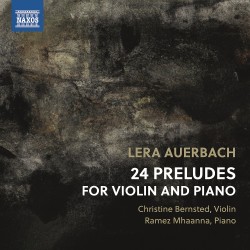 The Danish duo of violinist Christine Bernsted and pianist Ramez Mhaanna present an absolutely fascinating recital on Lera Auerbach 24 Preludes for Violin and Piano (Naxos 8.574464 chandos.net/products/catalogue/NX%204464).
The Danish duo of violinist Christine Bernsted and pianist Ramez Mhaanna present an absolutely fascinating recital on Lera Auerbach 24 Preludes for Violin and Piano (Naxos 8.574464 chandos.net/products/catalogue/NX%204464).
The Russian Auerbach, long resident in New York, wrote the work in 1999. One of three sets of 24 Preludes from that year – the others are for piano solo and cello and piano – it’s a cycle of compact works that follows the key scheme of Chopin’s 24 Preludes: major keys in a circle of fifths, each followed by its relative minor. Auerbach calls “looking at something familiar, yet from an unexpected perspective” vital to understanding them.
There’s a wide range of moods, dynamics and colours here – from calm and mysterious to intense, strident and passionate – that exploits the full registers of the instruments, all of it superbly portrayed by the duo in a wonderfully resonant recording.
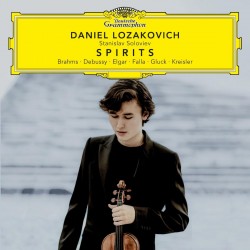 On Spirits the young Swedish violinist Daniel Lozakevich celebrates legendary violinists with a selection of miniatures he associates with great players from the past. Stanislav Soloviev is the pianist (Deutsche Grammophon 00028948624928 deutschegrammophon.com/en/catalogue/products/spirits-daniel-lozakovich-12864).
On Spirits the young Swedish violinist Daniel Lozakevich celebrates legendary violinists with a selection of miniatures he associates with great players from the past. Stanislav Soloviev is the pianist (Deutsche Grammophon 00028948624928 deutschegrammophon.com/en/catalogue/products/spirits-daniel-lozakovich-12864).
Elgar’s Salut d’amour and La Capricieuse open a recital that includes Debussy’s Clair de lune, da Falla’s Danse espagnole, Gluck’s Melodie, two of Brahms’ Hungarian Dances and Kreisler’s Liebeslied.
Lozakevich’s Romantic playing style and the warm, rich tone he draws from the 1727 “Le Reynier” Stradivarius are ideally suited to a delightful, if somewhat brief at 29 minutes, recital.
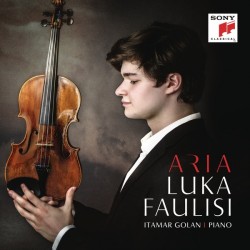 The young violinist Luka Faulisi makes his CD debut with Aria, a recital of operatic transcriptions with pianist Itamar Golan (Sony Classical 19658765272 sonyclassical.com/releases/releases-details/aria-1).
The young violinist Luka Faulisi makes his CD debut with Aria, a recital of operatic transcriptions with pianist Itamar Golan (Sony Classical 19658765272 sonyclassical.com/releases/releases-details/aria-1).
Faulisi, who grew up near the Paris Opéra, chose a program of operatic themes linking not only to the era of operatic transcriptions but also to great violinists of the past. Franz Waxman’s Carmen Fantasie is associated with both Isaac Stern and Jascha Heifetz. Lensky’s Aria from Tchaikovsky’s Eugene Onegin is heard in Leopold Auer’s arrangement, and Auer’s pupil Efram Zimbalist produced the Concert Phantasy on Rimsky-Korsakov’s Le coq d’or.
Roxana’s Song from Szymanowski’s opera Król Roger was arranged by his violinist collaborator Paul Kochanski. Wieniawski’s Fantasie brillante on Themes from Gounod’s Faust Op.20 is here, as is Faulisi’s Sempre libera, his own very brief arrangement of four themes from Verdi’s La Traviata.
Faulisi has a big sound and technique to burn, combining showmanship in the virtuosic tradition with musical taste and maturity in a really impressive debut.
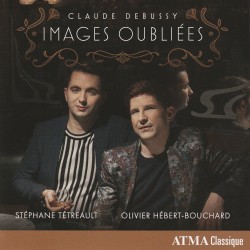 On Claude Debussy Images oubliées the duo of cellist Stéphane Tétreault and pianist Olivier Hébert-Bouchard presents a recital consisting mostly of their own arrangements of a selection of Debussy’s music for piano (ATMA Classique ACD2 2863 atmaclassique.com/en).
On Claude Debussy Images oubliées the duo of cellist Stéphane Tétreault and pianist Olivier Hébert-Bouchard presents a recital consisting mostly of their own arrangements of a selection of Debussy’s music for piano (ATMA Classique ACD2 2863 atmaclassique.com/en).
The only original work for cello and piano is the Cello Sonata, with the rest of the disc comprising pieces that span almost all of Debussy’s creative life, from the Danse bohémienne to the Page d’album, the three-part Images oubliées giving the CD its title. The arrangements are not always of the straightforward melody and accompaniment type, the cello and piano parts often being blended in what the performers call abstract textures, an approach most successfully displayed in the lovely Clair de lune that closes the disc.
There’s beautiful playing here, with the Domaine Forget recording location in Quebec guaranteeing top-level sound quality.
Listen to 'Claude Debussy Images oubliées' Now in the Listening Room
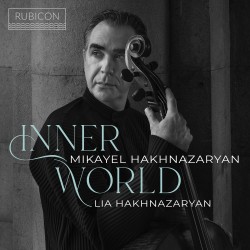 The Debussy Cello Sonata also turns up on Inner World, an outstanding recital by the Armenian cello and piano duo of Mikayel and Lia Hakhnazaryan described as a “musical exploration of the emotions of a musician discovering new worlds and searching for their inner voice and inner world” (Rubicon Classics RCD1083 rubiconclassics.com).
The Debussy Cello Sonata also turns up on Inner World, an outstanding recital by the Armenian cello and piano duo of Mikayel and Lia Hakhnazaryan described as a “musical exploration of the emotions of a musician discovering new worlds and searching for their inner voice and inner world” (Rubicon Classics RCD1083 rubiconclassics.com).
Other standard repertoire works are Rachmaninov’s Vocalise, Schumann’s Fantasiestücke Op.73, Bloch’s From Jewish Life and Tchaikovsky’s Valse sentimentale. Armenian music is represented by Khachaturian’s Dream, two pieces by Komitas featuring Artyom Minasyan on the traditional double-reed woodwind duduk and Adam Khudoyan’s impressive Sonata for cello solo No.1.
The brief Elegy by the Georgian composer Igor Loboda and the Australian Carl Vine’s quite fascinating Inner World for cello and pre-recorded CD bring a generous (80 minutes) and really high-quality disc to a close.
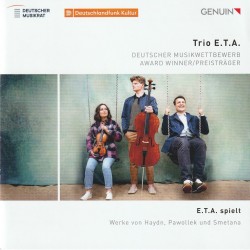 Winner of the 2021 German Music Competition, the Trio E.T.A. makes its CD debut with works by Haydn, Pawollek and Smetana (GENUIN GEN 23816 trio-e-t-a.com/en/home-2).
Winner of the 2021 German Music Competition, the Trio E.T.A. makes its CD debut with works by Haydn, Pawollek and Smetana (GENUIN GEN 23816 trio-e-t-a.com/en/home-2).
Haydn’s Piano Trio in C Major, Hob.XV:27 was one of three written during his second visit to London in 1796-97. The playing here is superb – light, agile and nuanced, with Till Hoffmann outstanding in the technically brilliant and more demanding piano part. The dazzling Presto Finale is worth the price of the CD on its own.
In the 2006 Piano Trio by Roman Pallowek (born 1971) overtones and harmonics in two short, slow and quiet movements create a mystical but brief soundscape. Smetana’s Piano Trio in G Minor Op.15 from 1855-56 is a passionate “epitaph full of memories” following the tragic death of his four-year-old daughter.
There’s lovely tone and balance throughout a beautifully-recorded recital, and a fine sense of ensemble in top-notch performances.
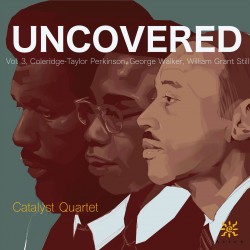 The Catalyst Quartet continues its ongoing multi-volume anthology of music by overlooked Black composers on the Azica Records label with Uncovered Vol.3, featuring string quartets by Coleridge-Taylor Perkinson (1932-2004), George Walker (1922-2018) and William Grant Still (1895-1978) (Azica71357 catalystquartet.com/uncovered).
The Catalyst Quartet continues its ongoing multi-volume anthology of music by overlooked Black composers on the Azica Records label with Uncovered Vol.3, featuring string quartets by Coleridge-Taylor Perkinson (1932-2004), George Walker (1922-2018) and William Grant Still (1895-1978) (Azica71357 catalystquartet.com/uncovered).
The three three-movement quartets are all beautifully crafted and immediately accessible. Perkinson’s String Quartet No.1 “Calvary” from 1956 is loosely based on the spiritual of the same name. Walker’s String Quartet No.1 “Lyric” from 1946 was his first major composition; the beautiful middle movement is often performed alone as Lyric for Strings.
The central work on the CD is Still’s Lyric Quartette from the early 1940s; the movements are musical representations of a plantation (a gorgeous movement), the mountains of Peru (incorporating an Incan folk melody) and a pioneer settlement.
Strong, resonant performances by the Catalyst Quartet showcase these three gems in the best possible way.
 The desire to promote an overlooked composer – albeit one now with an increasingly higher profile – is also the driving force behind Weinberg String Quartets Nos 4 and 16, the third volume in the ongoing series by the Arcadia Quartet of the complete string quartets of Mieczysław Weinberg (Chandos CHAN 20180 chandos.net/products/catalogue/CHAN%2020180).
The desire to promote an overlooked composer – albeit one now with an increasingly higher profile – is also the driving force behind Weinberg String Quartets Nos 4 and 16, the third volume in the ongoing series by the Arcadia Quartet of the complete string quartets of Mieczysław Weinberg (Chandos CHAN 20180 chandos.net/products/catalogue/CHAN%2020180).
As with previous volumes, the quartet chose works from two contrasting stylistic periods. The String Quartet No.4 in E-flat Major Op.20 from March 1945 followed Weinberg’s move to Moscow and reflects his affinity with Shostakovich, the war context particularly clear in the slow movement Largo marciale. The String Quartet No.16 in A-flat Minor Op.130 from 1981 was the last of four written in quick succession following the death of Shostakovich in 1975, as if Weinberg felt free to return to a genre his friend had dominated.
The previous volumes have garnered glowing reviews, and it’s easy to hear why: these are quite superb performances of works that “instantly captivated” the Arcadia members when they first encountered them.
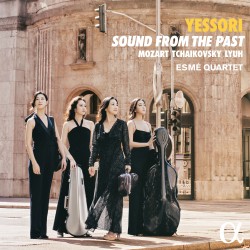 In 2018 the South Korean Esmé Quartet became the first all-female quartet to win the International String Quartet Competition at London’s Wigmore Hall, also taking four special awards including the Mozart performance prize. Mozart, Tchaikovsky and the quartet’s compatriot Soo Yeon Lyuh (b.1980) are the featured composers on their new CD Yessori – Sound from the Past (Alpha Classics ALPHA 923 outhere-music.com/en/artists/esme-quartet).
In 2018 the South Korean Esmé Quartet became the first all-female quartet to win the International String Quartet Competition at London’s Wigmore Hall, also taking four special awards including the Mozart performance prize. Mozart, Tchaikovsky and the quartet’s compatriot Soo Yeon Lyuh (b.1980) are the featured composers on their new CD Yessori – Sound from the Past (Alpha Classics ALPHA 923 outhere-music.com/en/artists/esme-quartet).
A finely judged performance of Mozart’s String Quartet No.19 in C Major K465 “Dissonance” opens the disc, with a particularly sensitive Andante. There’s an equally strong reading of Tchaikovsky’s String Quartet No.1 in D Major Op.11 with its famous Andante cantabile slow movement – in fact, the quartet members say that they chose the two quartets because they especially loved the two slow movements.
The title track was commissioned by the Kronos Quartet in 2016 and written for string quartet and the traditional two-string Korean haegeum; this is the premiere recording of the version for string quartet alone. Strongly influenced by traditional Korean music, it’s an extremely effective work.
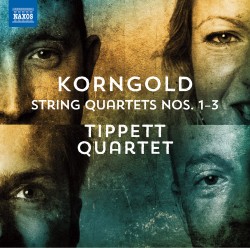 On Korngold String Quartets Nos.1-3 the Tippett Quartet celebrates its 25th anniversary with solid performances of the complete quartets by the Austrian child prodigy and composer Erich Wolfgang Korngold, until relatively recently best known for his brilliant Hollywood film scores from the 1930s and 1940s (Naxos 8.574428 naxos.com/CatalogueDetail/?id=8.574428).
On Korngold String Quartets Nos.1-3 the Tippett Quartet celebrates its 25th anniversary with solid performances of the complete quartets by the Austrian child prodigy and composer Erich Wolfgang Korngold, until relatively recently best known for his brilliant Hollywood film scores from the 1930s and 1940s (Naxos 8.574428 naxos.com/CatalogueDetail/?id=8.574428).
The String Quartet No.1 in A Major Op.16 is from 1923. The String Quartet No.2 in E-flat Major Op.26, written in 1933 and premiered in 1934, the year that Korngold, concerned about the rise of Nazi Germany moved to the United States, has a melodic and harmonic clarity that belies the conditions in which it was completed. The String Quartet No.3 in D Major Op.34 is from 1945, and despite its positive assertiveness made little impact at the time.
Don’t expect any Hollywood scoring here, as in his Violin Concerto – this is Korngold the gifted classical composer in three impressive and substantial works.
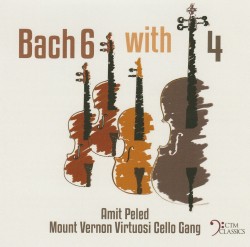 Cellist Amit Peled is joined by his Mount Vernon Virtuosi Cello Gang of the three cellists Natalia Vilchis, Jiaoyang Xu and Nick Pascucci, all former pupils of his on Bach 6 with 4, the world-premiere recording of an arrangement by Sahun Hong of Bach’s Cello Suite No.6 in D Major BWV1012 (CTM Classics 95269 22197 mountvernonvirtuosi.com).
Cellist Amit Peled is joined by his Mount Vernon Virtuosi Cello Gang of the three cellists Natalia Vilchis, Jiaoyang Xu and Nick Pascucci, all former pupils of his on Bach 6 with 4, the world-premiere recording of an arrangement by Sahun Hong of Bach’s Cello Suite No.6 in D Major BWV1012 (CTM Classics 95269 22197 mountvernonvirtuosi.com).
Peled plays the original solo cello part as written, with the other three cellos providing what amounts to a cross between an orchestral and a continuo accompaniment, blending well with the solo line. He calls looking at these monumental pieces in a different light and from an ensemble viewpoint “a magical experience.”
Tempos feel – perhaps unavoidably – possibly a bit less flexible than in a solo performance, but the quartet creates a warm, rich soundscape, albeit a somewhat brief one at only 32 minutes.
Listen to 'Bach 6 with 4' Now in the Listening Room
 Music of Turina and Castelnuovo-Tedesco is featured on Souvenir d’Espagne, the outstanding new CD from the Quatuor Byron with guitarist Matteo Mala. The four works – “shot through with Hispanic musical reminiscences” – show a range of influences from Franck and Debussy to Ravel and Andalusian music, with the spirit of the guitar never far away (Aparté AP308 apartemusic.com/produit/souvenir-despagne).
Music of Turina and Castelnuovo-Tedesco is featured on Souvenir d’Espagne, the outstanding new CD from the Quatuor Byron with guitarist Matteo Mala. The four works – “shot through with Hispanic musical reminiscences” – show a range of influences from Franck and Debussy to Ravel and Andalusian music, with the spirit of the guitar never far away (Aparté AP308 apartemusic.com/produit/souvenir-despagne).
The three works by Turina, who was born in Seville, are all extremely attractive: La oración del torero Op.34 (The bullfighter’s prayer) from 1925; the String Quartet “de la guitarra” Op.4 from 1911; and the Serenata Op.87 from 1935, a dramatic and unsettled work perhaps reflective of the contemporary events in Spain.
The Italian Castelnuovo-Tedesco would have to go back several centuries to find his Spanish roots, but no matter: his Guitar Quintet Op.143 from 1950, dedicated to the great Spanish guitarist Andrés Segovia, is indeed shot through with Spanish colour and warmth.
In 1598 John Dowland, unable to obtain a position in the court of Elizabeth I, joined the Danish court of Christian IV, whose sister Anne was married to James VI of Scotland, soon to succeed to the English throne on the death of Elizabeth in 1603. Dowland continued to publish in London, and in 1604 produced his greatest instrumental work, Lachrimae or Seven Tears for lute and five viols, dedicated to Anne of Denmark, Queen of England.
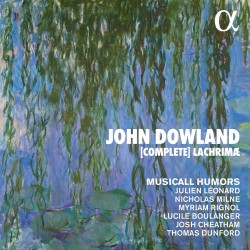 On John Dowland [Complete] Lachrimæ the cycle of seven Lachrimae pavans and 14 “divers other Pavans, Galliards and Almands” is given a captivating, entrancing and quite brilliant performance by the Musicall Humors ensemble of lutenist Thomas Dunford and viola da gambists Julien Léonard, Nicholas Milne, Myriam Rignol, Lucile Boulanger and Josh Cheatham (Alpha Classics ALPHA944 outhere-music.com/en/albums/dowland-lachrimae-alpha-collection).
On John Dowland [Complete] Lachrimæ the cycle of seven Lachrimae pavans and 14 “divers other Pavans, Galliards and Almands” is given a captivating, entrancing and quite brilliant performance by the Musicall Humors ensemble of lutenist Thomas Dunford and viola da gambists Julien Léonard, Nicholas Milne, Myriam Rignol, Lucile Boulanger and Josh Cheatham (Alpha Classics ALPHA944 outhere-music.com/en/albums/dowland-lachrimae-alpha-collection).
Imbued with the sense of melancholy so typical of Tudor England, the music here is given added colour by the violists taking turns playing the leading voice line.
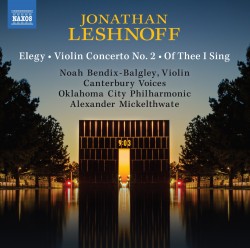 Works of remembrance, memorialization and hopefulness are featured on Jonathan Leshnoff Elegy | Violin Concerto No.2 | Of Thee I Sing, the fifth in an ongoing series devoted to the music of the Baltimore-based composer who turns 50 this year. Noah Bendix-Balgley, the North Carolina-born first concertmaster of the Berlin Philharmonic is the soloist in the concerto, with Alexander Mickelthwate leading the Oklahoma City Philharmonic (Naxos 8.559927 jonathanleshnoff.com/listen).
Works of remembrance, memorialization and hopefulness are featured on Jonathan Leshnoff Elegy | Violin Concerto No.2 | Of Thee I Sing, the fifth in an ongoing series devoted to the music of the Baltimore-based composer who turns 50 this year. Noah Bendix-Balgley, the North Carolina-born first concertmaster of the Berlin Philharmonic is the soloist in the concerto, with Alexander Mickelthwate leading the Oklahoma City Philharmonic (Naxos 8.559927 jonathanleshnoff.com/listen).
Leshnoff’s music features pulsating rhythms and unpredictable accents reminiscent of Philip Glass together with contrasting melodic lyricism and lush harmonies, the latter clearly in evidence in the 2022 Elegy, a work much in the style of Barber’s Adagio for Strings.
The beautiful second movement, subtitled Chokhmah Yud and scored for strings and harp is the emotional core of the terrific 2017 four-movement Violin Concerto No.2, with Bendix-Balgley the outstanding soloist.
The Canterbury Voices appear in the closing section of the lengthy and impressive Of Thee I Sing, written in 2020 for the 25th anniversary of the Oklahoma City bombing.


